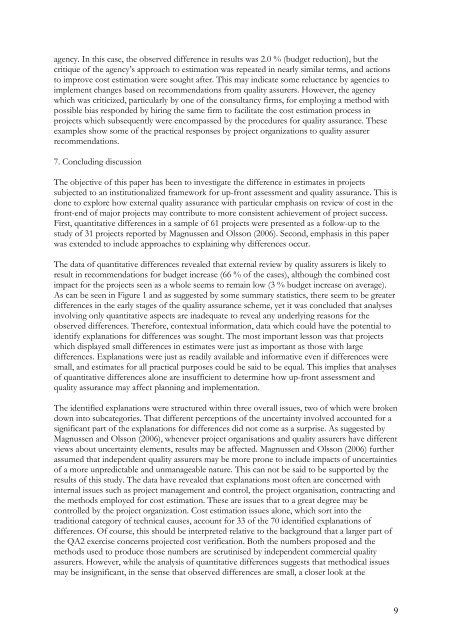Link to thesis. - Concept - NTNU
Link to thesis. - Concept - NTNU
Link to thesis. - Concept - NTNU
- No tags were found...
Create successful ePaper yourself
Turn your PDF publications into a flip-book with our unique Google optimized e-Paper software.
agency. In this case, the observed difference in results was 2.0 % (budget reduction), but thecritique of the agency’s approach <strong>to</strong> estimation was repeated in nearly similar terms, and actions<strong>to</strong> improve cost estimation were sought after. This may indicate some reluctance by agencies <strong>to</strong>implement changes based on recommendations from quality assurers. However, the agencywhich was criticized, particularly by one of the consultancy firms, for employing a method withpossible bias responded by hiring the same firm <strong>to</strong> facilitate the cost estimation process inprojects which subsequently were encompassed by the procedures for quality assurance. Theseexamples show some of the practical responses by project organizations <strong>to</strong> quality assurerrecommendations.7. Concluding discussionThe objective of this paper has been <strong>to</strong> investigate the difference in estimates in projectssubjected <strong>to</strong> an institutionalized framework for up-front assessment and quality assurance. This isdone <strong>to</strong> explore how external quality assurance with particular emphasis on review of cost in thefront-end of major projects may contribute <strong>to</strong> more consistent achievement of project success.First, quantitative differences in a sample of 61 projects were presented as a follow-up <strong>to</strong> thestudy of 31 projects reported by Magnussen and Olsson (2006). Second, emphasis in this paperwas extended <strong>to</strong> include approaches <strong>to</strong> explaining why differences occur.The data of quantitative differences revealed that external review by quality assurers is likely <strong>to</strong>result in recommendations for budget increase (66 % of the cases), although the combined costimpact for the projects seen as a whole seems <strong>to</strong> remain low (3 % budget increase on average).As can be seen in Figure 1 and as suggested by some summary statistics, there seem <strong>to</strong> be greaterdifferences in the early stages of the quality assurance scheme, yet it was concluded that analysesinvolving only quantitative aspects are inadequate <strong>to</strong> reveal any underlying reasons for theobserved differences. Therefore, contextual information, data which could have the potential <strong>to</strong>identify explanations for differences was sought. The most important lesson was that projectswhich displayed small differences in estimates were just as important as those with largedifferences. Explanations were just as readily available and informative even if differences weresmall, and estimates for all practical purposes could be said <strong>to</strong> be equal. This implies that analysesof quantitative differences alone are insufficient <strong>to</strong> determine how up-front assessment andquality assurance may affect planning and implementation.The identified explanations were structured within three overall issues, two of which were brokendown in<strong>to</strong> subcategories. That different perceptions of the uncertainty involved accounted for asignificant part of the explanations for differences did not come as a surprise. As suggested byMagnussen and Olsson (2006), whenever project organisations and quality assurers have differentviews about uncertainty elements, results may be affected. Magnussen and Olsson (2006) furtherassumed that independent quality assurers may be more prone <strong>to</strong> include impacts of uncertaintiesof a more unpredictable and unmanageable nature. This can not be said <strong>to</strong> be supported by theresults of this study. The data have revealed that explanations most often are concerned withinternal issues such as project management and control, the project organisation, contracting andthe methods employed for cost estimation. These are issues that <strong>to</strong> a great degree may becontrolled by the project organization. Cost estimation issues alone, which sort in<strong>to</strong> thetraditional category of technical causes, account for 33 of the 70 identified explanations ofdifferences. Of course, this should be interpreted relative <strong>to</strong> the background that a larger part ofthe QA2 exercise concerns projected cost verification. Both the numbers proposed and themethods used <strong>to</strong> produce those numbers are scrutinised by independent commercial qualityassurers. However, while the analysis of quantitative differences suggests that methodical issuesmay be insignificant, in the sense that observed differences are small, a closer look at the9
















